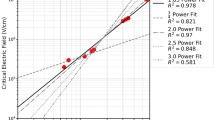Abstract
A detailed description and analysis of the Fermi kinetics transport (FKT) equations for simulating charge transport in semiconductor devices is presented. The fully coupled nonlinear discrete FKT equations are elaborated, as well as solution methods and work-flow for the simulation of RF electronic devices under large-signal conditions. The importance of full-wave electromagnetics is discussed in the context of high-speed device simulation, and the meshing requirements to integrate the full-wave solver with the transport equations are given in detail. The method includes full semiconductor band structure effects to capture the scattering details for the Boltzmann transport equation. The method is applied to high-speed gallium nitride devices. Finally, numerical convergence and stability examples provide insight into the mesh convergence behavior of the deterministic solver.

















Similar content being viewed by others
References
Hess, K.: Advanced Theory of Semiconductor Devices. Prentice-Hall, Englewood Cliffs (2000)
Jacoboni, C.: Theory of Electron Transport in Semiconductors: A Pathway from Elementary Physics to Nonequilibrium Green Functions. Springer, Berlin (2010)
Metropolis, N., Ulam, S.: The Monte Carlo method. J. Am. Stat. Assoc. 44(247), 335 (1949)
Fischetti, M., Laux, S.: Monte Carlo analysis of electron transport in small semiconductor devices including band-structure and space-charge effects. Phys. Rev. B 38(14), 9721 (1988)
Saraniti, M., Goodnick, S.M.: Hybrid fullband cellular automaton/Monte Carlo approach for fast simulation of charge transport in semiconductors. IEEE Trans. Electron Devices 47(10), 1909 (2000)
Willis, K.J., Hagness, S.C., Knezevic, I.: Multiphysics simulation of high-frequency carrier dynamics in conductive materials. J. Appl. Phys. 110, 1 (2011)
Guerra D.: GaN HEMT modeling and design for millimeter and sub-millimeter wave power amplifiers through Monte Carlo particle-based device simulations. Ph.D. thesis (2011)
Latorre-Rey, A.D., Sabatti, F.F.M., Albrecht, J.D., Saraniti, M.: Hot electron generation under large-signal radio frequency operation of GaN high-electron-mobility transistors. Appl. Phys. Lett. 013506, 111 (2017). https://doi.org/10.1063/1.4991665
Yamakawa, S., Goodnick, S., Aboud, S., Saraniti, M.: Quantum corrected full-band cellular Monte Carlo simulation of AlGaN/GaN HEMTs. J. Comput. Electron. 3(3–4), 299 (2004)
Sadi, T., Kelsall, R.W., Pilgrim, N.J.: Investigation of self-heating effects in submicrometer GaN/AlGaN HEMTs using an electrothermal Monte Carlo method. IEEE Trans. Electron Devices 53(12), 2892 (2006)
Sridharan, S., Venkatachalam, A., Yoder, P.D.: Electrothermal analysis of AlGaN/GaN high electron mobility transistors. J. Comput. Electron. 7(3), 236 (2008)
Ashok, A., Vasileska, D., Hartin, O.L., Goodnick, S.M.: Electrothermal Monte Carlo simulation of GaN HEMTs including electron-electron interactions. IEEE Trans. Electron Devices 57(3), 562 (2010)
Russo, S., Carlo, A.D.: Influence of the source-gate distance on the AlGaN/GaN HEMT performance. IEEE Trans. Electron Devices 54(5), 1071 (2007)
Scharfetter, D.L., Gummel, H.K.: Large-signal analysis of a silicon read diode oscillator. IEEE Trans. Electron Devices ED–16(1), 64 (1969)
Stratton, R.: Diffusion of hot and cold electrons in semiconductor barriers. Phys. Rev. 126(6), 2002 (1962)
Blotekjaer, K.: Transport equations for electrons in two-valley semiconductors. IEEE Trans. Electron Devices ED–17(1), 38 (1970)
Grasser, T., Tang, T.W., Kosina, H., Selberherr, S.: A review of hydrodynamic and energy-transport models for semiconductor device simulation. Proc. IEEE 91(2), 251 (2003)
Synopsys. Sentaurus device user guide (2013)
Brannick, A., Zakhleniuk, N.A., Ridley, B.K., Eastman, L.F., Shealy, J.R., Schaff, W.J.: Hydrodynamic simulation of surface traps in the AlGaN/GaN HEMT. Microelectron. J. 40(3), 410 (2009)
Wang, X.D., Hu, W.D., Chen, X.S., Lu, W.: The study of self-heating and hot-electron effects for AlGaN/GaN double-channel HEMTs. IEEE Trans. Electron Devices 59(5), 1393 (2012)
Vitanov, S., Palankovski, V., Maroldt, S., Quay, R., Murad, S., Rödle, T., Selberherr, S.: Physics-based modeling of GaN HEMTs. IEEE Trans. Electron Devices 59(3), 685 (2012)
Bhardwaj, S., Sensale-Rodriguez, B., Xing, H.G., Volakis, J.L.: Full-wave hydrodynamic model for predicting THz emission from grating-gate RTD-gated plasma wave HEMTs. In: 2015 73rd Annual Device Research Conference (DRC) (2015)
Grupen, M.: An alternative treatment of heat flow for charge transport in semiconductor devices. J. Appl. Phys. 106(12), 123702 (2009)
Grupen, M.: Energy transport model with full band structure for GaAs electronic devices. J. Comput. Electron. 10(3), 271 (2011)
Grupen, M.: Full wave electromagnetics and hot electron transport with electronic band structure for high speed semiconductor device simulation. IEEE Trans. Microw. Theory Tech. 62(12), 2868 (2014)
Grupen, M.: GaN high electron mobility transistor simulations with full wave and hot electron effects. IEEE Trans. Electron Devices 63(8), 3096 (2016)
Franz, A., Franz, G., Selberherr, S., Ringhofer, C., Markowich, P.: Finite boxes—a generalization of the finite-difference method suitable for semiconductor device simulation. IEEE Trans. Electron Devices 30(9), 1070 (1983)
Aurenhammer, F., Klein, R., Lee, D.T.: Voronoi Diagrams and Delaunay Triangulations. World Scientific Publishing Co Inc, Singapore (2013)
Bowyer, A.: Computing Dirichlet tessellations. Comput. J. 24(2), 162 (1981)
Watson, D.F.: Computing the n-dimensional Delaunay tessellation with application to Voronoi polytopes. Comput. J. 24(2), 167 (1981)
Aurenhammer, F.: Voronoi diagrams—a survey of a fundamental geometric data structure. ACM Comput. Surv. (CSUR) 23(3), 345 (1991)
Lee, D.T., Schachter, B.J.: Two algorithms for constructing a Delaunay triangulation. Int. J. Comput. Inf. Sci. 9(3), 219 (1980)
Chew, L.P.: Constrained Delaunay triangulations. In: Proceedings of the Third Annual Symposium on Computational Geometry—SCG ’87. ACM Press, New York, pp. 215–222 (1987)
Geuzaine, C., Remacle, J.F.: Gmsh: A 3-D finite element mesh generator with built-in pre- and post-processing facilities. Int. J. Numer. Methods Eng. 79(11), 1309 (2009)
Si, H.: TetGen, a Delaunay-based quality tetrahedral mesh generator. ACM Trans. Math. Softw. 41(2), 1 (2015)
Du, Q., Faber, V., Gunzburger, M.: Centroidal Voronoi tessellations: applications and algorithms. SIAM Rev. 41(4), 637 (1999)
Xie, Z.Q., Hassan, O., Morgan, K.: Tailoring unstructured meshes for use with a 3D time domain co-volume algorithm for computational electromagnetics. Int. J. Numer. Methods Eng. 87((July 2010),), 48 (2011)
Sazonov, I., Wang, D., Hassan, O., Morgan, K., Weatherill, N.: A stitching method for the generation of unstructured meshes for use with co-volume solution techniques. Comput. Methods Appl. Mech. Eng. 195(13–16), 1826 (2006)
Walton, S., Hassan, O., Morgan, K.: Advances in co-volume mesh generation and mesh optimisation techniques. Comput. Struct. 181, 70 (2017)
Hitschfeld, N., Conti, P., Fichtner, W.: Mixed element trees: a generalization of modified octrees for the generation of meshes for the simulation of complex 3-D semiconductor device structures. IEEE Trans. Comput. Aided Des. Integr. Circuits Syst. 12(11), 1714 (1993)
Conti, P., Hitschfeld, N., Fichtner, W.: An octree-based mixed element grid allocator for the simulation of complex 3-D device structures. IEEE Trans. Comput. Aided Des. Integr. Circuits Syst. 10(10), 1231 (1991)
Conti, P., Tomizawa, M., Yoshii, A.: Generation of oriented three-dimensional Delaunay grids suitable for the control volume integration method. Int. J. Numer. Methods Eng. 37(19), 3211 (1994). https://doi.org/10.1002/nme.1620371902
Synopsys. Mesh Generation Tools User Guide (2013)
Krause, J.: On boundary conforming anisotropic Delaunay meshes. Ph.D. thesis (2001)
Hitschfeld, N., Villablanca, L., Krause, J., Rivara, M.C.: Improving the quality of meshes for the simulation of semiconductor devices using Lepp-based algorithms. Int. J. Numer. Methods Eng. 58(2), 333 (2003)
Miller, N.C., Albrecht, J.D., Grupen, M.: Delaunay–Voronoi surface integration: a full-wave electromagnetics discretization for electronic device simulation. Int. J. Numer. Model. Electron. Netw. Devices Fields 29(5), 817 (2016)
Goano, M.: Series expansion of the Fermi-Dirac integral over the entire domain of real j and x. Solid State Electron. 36(2), 217 (1993)
Sridharan, S., Christensen, A., Venkatachalam, A., Graham, S., Yoder, P.D.: Temperature- and doping-dependent anisotropic stationary electron velocity in wurtzite GaN. IEEE Electron Device Lett. 32(11), 1522 (2011)
Keysight. www.keysight.com (2017)
Marino, F.A., Faralli, N., Palacios, T., Ferry, D.K., Goodnick, S.M., Saraniti, M.: Effects of threading dislocations on AlGaN/GaN high-electron mobility transistors. IEEE Trans. Electron Devices 57(1), 353 (2010)
Goodnick, S.M., Saraniti, M.: Modeling and simulation of terahertz devices. IEEE Microw. Mag. 13(7), 36 (2012)
Miller, N.C., Albrecht, J.D., Grupen, M.: Delaunay–Voronoi surface integration: a full-wave electromagnetics discretization for electronic device simulation. In: 2016 74th Annual Device Research Conference (DRC) (IEEE), pp. 1–2 (2016)
Khalil, H.K.: Nonlinear Systems, 3rd edn. Prentice Hall, Upper Saddle River (2002)
Jungel, A.: Qualitative behavior of solutions of a degenerate nonlinear drift-diffusion model for semiconductors. Math. Models Methods Appl. Sci. 5(4), 497 (1995)
Acknowledgements
This material is based upon work supported by the Air Force Office of Scientific Research under Award Number FA9550-17RYCOR495 and the AF STTR Program (# FA8650-16-C-1764). Sandia National Laboratories is a multimission laboratory managed and operated by National Technology and Engineering Solutions of Sandia LLC, a wholly owned subsidiary of Honeywell International Inc., for the US Department of Energy’s National Nuclear Security Administration under contract DE-NA0003525. This paper describes objective technical results and analysis. Any subjective views or opinions that might be expressed in the paper do not necessarily represent the views of the US Department of Energy or the United States Government. SAND Number: SAND2018-9525 J.
Author information
Authors and Affiliations
Corresponding author
Rights and permissions
About this article
Cite this article
Miller, N.C., Grupen, M., Beckwith, K. et al. Computational study of Fermi kinetics transport applied to large-signal RF device simulations. J Comput Electron 17, 1658–1675 (2018). https://doi.org/10.1007/s10825-018-1242-5
Published:
Issue Date:
DOI: https://doi.org/10.1007/s10825-018-1242-5




